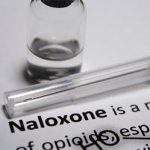1. Strang J, Bird SM, Dietze P, Gerra G, McLellan AT. Take-home emergency naloxone to prevent deaths from heroin overdose. BMJ 2014;349:g6580.
2. Boyer EW. Management of opioid analgesic overdose. N Engl J Med 2012;367:146-55.
3. Dietze P, Jauncey M, Salmon A, et al. Effect of Intranasal vs Intramuscular Naloxone on Opioid Overdose: A Randomized Clinical Trial. JAMA Netw Open 2019;2:e1914977.
4. McDonald R, Campbell ND, Strang J. Twenty years of take-home naloxone for the prevention of overdose deaths from heroin and other opioids-Conception and maturation. Drug and alcohol dependence 2017;178:176-87.
5. Dwyer R, Olsen A, Fowlie C, et al. An overview of take-home naloxone programs in Australia. Drug and alcohol review 2018;37:440-9.
6. Lenton S, Dietze P, Olsen A, Wiggins N, McDonald D, Fowlie C. Working together: Expanding the availability of naloxone for peer administration to prevent opioid overdose deaths in the Australian Capital Territory and beyond. Drug and alcohol review 2015;34:404-11.
7. Dietze PM, Draper B, Olsen A, et al. Does training people to administer take-home naloxone increase their knowledge? Evidence from Australian programs. Drug and alcohol review 2018;37:472-9.
8. Lenton SR, Dietze PM, Jauncey M. Australia reschedules naloxone for opioid overdose. The Medical journal of Australia 2016;204:146-7.
9. Lintzeris N, Monds LA, Bravo M, et al. Designing, implementing and evaluating the overdose response with take-home naloxone model of care: An evaluation of client outcomes and perspectives. Drug and alcohol review 2020;39:55-65.
10. Roxburgh A, Hall WD, Gisev N, Degenhardt L. Characteristics and circumstances of heroin and pharmaceutical opioid overdose deaths: Comparison across opioids. Drug and alcohol dependence 2019;205:107533.
11. Nielsen S, Peacock A, Lintzeris N, Bruno R, Larance B, Degenhardt L. Knowledge of Opioid Overdose and Attitudes to Supply of Take-Home Naloxone Among People with Chronic Noncancer Pain Prescribed Opioids. Pain Med 2018;19:533-40.
12. Davis C, Webb D, Burris S. Changing law from barrier to facilitator of opioid overdose prevention. J Law Med Ethics 2013;41 Suppl 1:33-6.
13. Seaman SR, Brettle RP, Gore SM. Mortality from overdose among injecting drug users recently released from prison: database linkage study. BMJ 1998;316:426-8.
14. Stoove MA, Dietze PM, Jolley D. Overdose deaths following previous non-fatal heroin overdose: record linkage of ambulance attendance and death registry data. Drug and alcohol review 2009;28:347-52.
15. Moore C, Lloyd G, Oretti R, Russell I, Snooks H. Paramedic-supplied 'Take Home' Naloxone: protocol for cluster randomised feasibility study. BMJ Open 2014;4:e004712.
16. Strang J, McDonald R, Campbell G, et al. Take-Home Naloxone for the Emergency Interim Management of Opioid Overdose: The Public Health Application of an Emergency Medicine. Drugs 2019;79:1395-418.











